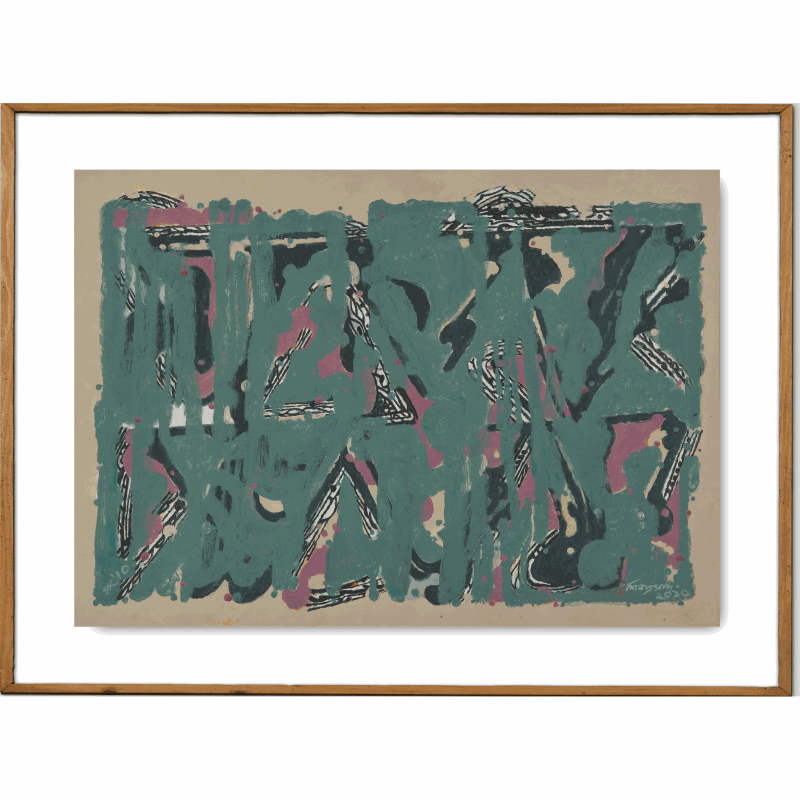The Dream of an Idiot
Sibaprasad Karchaudhuri
Tapestry, Painting, Drawing, Prints
Curated by Ushmita Sahu
The Dream of an Idiot, a survey show of artist and pedagogue Sibaprasad Karchaudhuri, encompasses the significant phases of Karchaudhuri's long and productive career across four decades, bringing to light the rich consonance that marks his practice. The exhibition is curated by Ushmita Sahu, the director and head curator of Emami Art.
A weaver, painter, printmaker and designer, Karchaudhuri (born in 1944) studied at the Government College of Art and Craft, Calcutta, from where he graduated in 1966 in applied arts, a subject he had enrolled under parental insistence. Karchaudhuri, however, loved painting in his spare time, and unlike most artists in the 1960s Bengal, who favoured figurative art, he was attracted to a non-figurative fluid approach. After completing his studies, he started working at the Calico Mill in Ahmedabad. 1968 was pivotal in his life when several young designers from the mill were sent for training in the newly established textile and fibre arts department at the National Institute of Design under the guidance of renowned weaver and textile designer Nelly Sethna and the influential Finnish textile designer Helena Perheentupa who joined as faculty. The institution's vibrant cultural atmosphere and Perheentupa's eclectic modernist outlook and experimental approach to teaching and making had a lasting impact on him. Karchaudhuri's inclination towards abstraction was redefined at NID, and his work started imbibing elements from Indian and European design and tapestry traditions. Looking back, black-and-white drawing exercises in Perheentupa's classes, his interactions with her and NID's radical new method of teaching informed his understanding of design and textile weaving techniques. He also had the opportunity to learn about loom weaving from Nelly Sethna.
From NID, he went on to work as an art designer in the Weavers Service Center in 1969, where he worked with professional weavers for two decades, moving over the years between Varanasi, Bhagalpur and Kolkata. The WSCs, founded by Pupul Jayakar, aimed to create a symbiotic relationship of learning and facilitation between artisans and artists employed at the various centres to help develop and modify designs. Karchaudhuri started imbibing lessons he learnt from the artisans in his experiments, creating massive tapestries. Although, for him, the mass production and commercial aspect were secondary to the artistic and craft aspect of making, like many of the painters and sculptors employed by the WSC, the artisanal and creative collaboration was reflected in his work. In the mid-1980s, he joined as a regular faculty at NID's Department of textile design, teaching there for almost a year before he moved to California, where he took up printmaking under Geoffrey Bowman at San Jose University. All these diverse learning experiences enabled him to understand the essential roles of form and colour, crafts and material in creating artwork without extraneous content.
He returned to India and worked once more at the WSC before moving on to the next critical chapter of his life in the 1990s when he joined the design department at Kala Bhavana. A perceptive teacher and pedagogue, he contributed to revamping the department, particularly its creative design section, based on an extensive syllabus made by KG Subramanyan. The KG syllabus explored functional designs, as taught historically in the institution, and expressional design, which aimed to connect the curriculum to global modernist trends and art practice. In his teaching, Karchaudhuri emphasised the expressional, introducing exercises with the design source material. This period also defines his engagement with the frame loom as a tool for creative expression. This kind of loom is a basic square frame that allows the warp yarns held at tension, to be hand knotted/interlaced with weft yarns allowing textured pile heights or tufts of organic fibre with a three-dimensional effect to be left undisturbed on the surface. Karchaudhuri's body of wall hangings is characterised by diligent craftsmanship, simplicity of form, and an organic approach. These evocative tapestries made of hemp, cotton, wool and other natural fibres form a significant part of his variegated oeuvre. In an essay for Karchaudhuri's solo exhibition, KG Subramanyan wrote, 'Shiva Prasad's tapestries are delightfully ambivalent. At one look, they are abstract fields where broken lines, zig-zags and patches of colour waltz around; at another, they evoke a landscape or scene with various atmospheric nuances, though he is abstemious, even austere, in his use of colour and other devices. But it is this halfway house, this see-sawing between design and description, that is their unique attraction. It provokes the viewer's interest and sustains it through a play of hide and seek.'
Karchaudhuri's work, motifs and colours have always been impacted by where he lives and works and its physical environs, and one can see that his style has changed with the change of location – from Kolkata to Bhagalpur to Santiniketan. An oft-repeated motif - the triangle, inverted or upright, has traces to the local tribal community as well as traditional Indian temple weaving motifs. Indeed, as evident in the works on view, Karchaudhuri views these abstract forms and motifs not as opposed to realism but as linked to the idea of the origin of life and expression itself and open to interpretation. Approaching his eightieth year, Karchaudhuri divides his daily studio time between painting and drawing, more recently taking up small tapestries again. The artist has always tried to inform his drawings and paintings with a similar fluidity; hence, these, too, have a distinctive visual and pictorial quality reminiscent of the woven element. While the exhibition is witness to the artist's maturity of style and the use of the material as experimentation, it is also an elegy to his long engagement with form as a field of profound experience.
Sibaprasad Karchaudhuri lives and works in Santiniketan, West Bengal, India.
The title of the exhibition is taken from an eponymous work by Karchaudhuri

